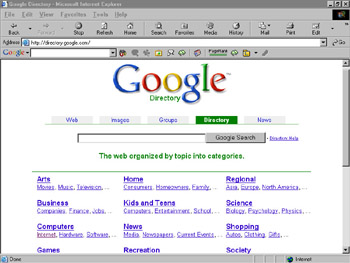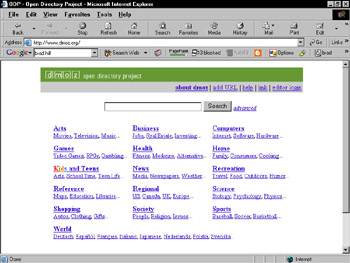Understanding Google Directory
|
| < Day Day Up > |
|
First things first. Google Directory, like most other directories, is self- explanatory on the face of it. You just need to visit the front page to get started. Here it is:
directory.google.com
Alternatively, click the Directory link on the main Google home page, or use the Google Toolbar (see Chapter 9) to go straight there. Figure 3-1 shows the home page of the Google Directory.

Figure 3-1: The Google Directory home page. Start exploring by clicking a category or subcategory.
Click any of the main category links or any of the subcategory links to get started. Many more subcategories exist in directory strata beneath the front page. However, you needn’t dig deep before encountering results: Most main category pages list primary Web sites for that category in addition to the first level of subcategories for that topic. Figure 3-2 illustrates how this structure works; I have scrolled down the page a bit to show the subcategories and the first few primary site links.

Figure 3-2: The main News category page, showing second-level subcategories and primary site links.
Google Directory is not an original work, but it’s enhanced by original technology. The directory selections — that is, the categories, subcategories, and site selections — represent the work of Open Directory Project, a volunteer organization begun in 1998 and dedicated to cataloguing the World Wide Web. No Web catalogue can ever be complete, because of the nearly immeasurable size and ever-changing nature of the beast. Open Directory Project uses the zeal and talent of thousands of topical editors who select directory listings. About one-and-a-half million sites are listed as of this writing.
Open Directory is open to the extreme. Modeled on the open source software movement, in which resulting software programs are not owned and anybody can contribute to their development, Open Directory is distributed free of charge to many of the most important Web portals on the Internet, including Netscape (which acquired the Open Directory organization in 1998 and oversaw development of this free directory), Lycos, and of course Google. Accordingly, you can view the nearly identical directory (allowing for minor differences due to distribution time lag) at several online destinations, including the Open Directory home page (see the figure):
www.dmoz.org
Google adds unique value to Open Directory and makes it its own (as Randy Jackson would say on American Idol) by imposing its PageRank structure on the Open Directory template. That means the site selections in each category and subcategory are ordered by Google’s popularity and importance formulas. In other locations, including its home site, Open Directory is organized alphabetically.

The directory runs deep — it’s not hard to drill down six levels in many subjects. Don’t give up early. Searching in a lower-level category yields interesting results.
| Remember | When you search the Web within the directory, you’re not searching the entire Google Directory. You’re shifting your search over to the Web index, which is separate. To search the entire Google Directory, go to the directory home page and use that keyword box. |
| Tip | You might think that searching in a narrow subcategory is pointless because a quick scroll down the page shows you what sites are listed. But when Google searches a category, it doesn’t match your keywords against only the words on the category page; it searches the content of the listed pages. This throws the door wide open, but in a small topic area. Searching in a narrow directory category results in extremely rewarding hits. |
Figure 3-3 shows a subcategory page, in this case a second-level page in the News category. Two items on subcategory pages are worth noting:
-
The directory path is displayed above the Categories banner. Figure 3-3 is a second-level page with a short path. Lower-level pages have longer paths, and each step you climb down is linked, so you can leap back upward along the path.
-
The Related Categories section, under the Categories banner, links to directory categories that share some degree of topicality with your current category.

Figure 3-3: A subcategory Page with related Categories listed.
|
| < Day Day Up > |
|
EAN: 2147483647
Pages: 188